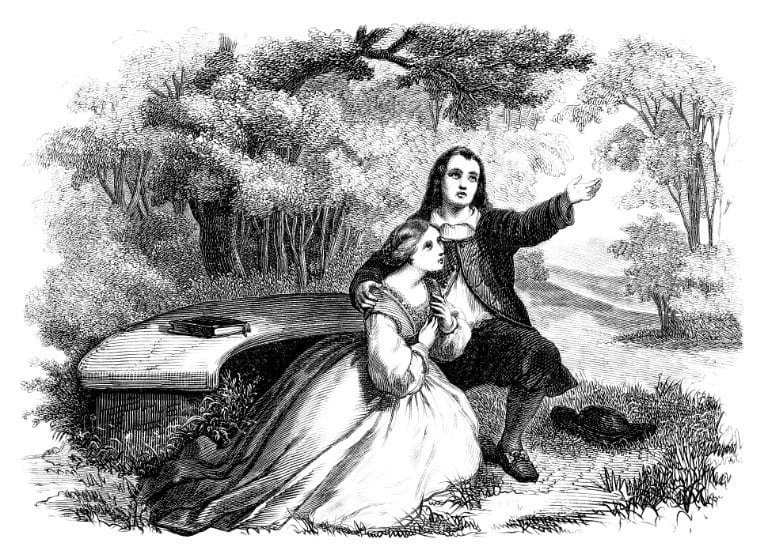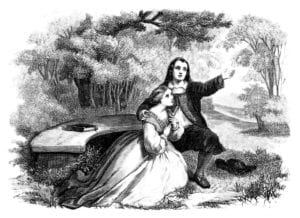Shakespeare spent most of his working life in one of the most populous cities in Europe, but his childhood was spent in quite rural surroundings, close to the Forest of Arden. Forests in his plays seem to enjoy a symbolic role as places of refuge and escape – even perhaps of freedom. Often touched with magic, and associated with warm summer nights, they may also connote love, romance and fertility – though they may at times have somewhat more sinister associations too.
In “A Midsummer Night’s Dream” the forest explores many of these roles. Initially the forest to which the young lovers are drawn serves as a refuge from an older generation driven by patriarchal values. It seems at first – as Hermia (in love with Lysander) resists her father’s injunction to marry Demetrius – to be a place where the oppressive culture of the family and of society can be escaped. But as the play develops, the forest becomes a locus of magic and romance, even of a kind of surreal absurdity that defies the straighter conventions of Athens, the city and its leaders. Shakespeare’s plays are often constructed around binary oppositions – parallels, oppositions, juxtapositions – and the contrast between city and forest is a subtext of the play.
“As You Like It” was written around four years after “A Midsummer Night’s Dream”, and it develops many of these themes. Rosalind (like Hermia) is an outsider in a society that has no place for her: the court of her uncle who has usurped her father as Duke. Her instinct is to head for the forest accompanied by her cousin Celia, and her liberation from her past life is symbolised by a change of name and (apparent) gender: as if to say that in the forest, one can discover one’s true self, affirming the theme of freedom from society. Once again, romance is foregrounded as Rosalind is able to explore her love for Orlando, and magical themes (though not as pervasive as in “A Midsummer Night’s Dream”) are reflected in the appearance of the lioness from whom Orlando rescues Oliver. The final scene features four weddings, alongside the news that the usurping brother has abdicated, thus clearing the way for a return to the court now restored to Rosalind’s father.
Whatever its limitations, “The Merry Wives of Windsor” explores some of the same themes. Set in an English town no larger than Stratford – the only Shakespeare play outside the Histories to be set in England – the play gathers to a conclusion in Windsor Forest, in which surreal comedy combines with romance at midnight to reinforce the sense that the forest is a place of magic and light hearts. Falstaff emerges as the butt of the practical joke arranged by the married women he has been pursuing, but takes the trick in good part to a background of Anne’s marriage to Fenton.
But escape to the forest in Shakespeare is not always a matter of light hearts and romance. In “Timon of Athens” the forest is again a refuge for a central character who comes to feel that society has nothing to offer him. Once again, Shakespeare’s tendency to construct his work around binary oppositions reveals (in the first half of the play) a generous and highly sociable central character driven (as the play progresses) towards misanthropy by what he sees as society’s failure to reciprocate his open spirit. He retreats to the forest, where his anger at his largely self-inflicted fate is expressed in a craving for revenge that eventually destroys him. “Timon of Athens” is one of Shakespeare’s later plays – written around 1608 – and it is clear that though some strains of his original idea of the forest have survived, there has also been a darkening in his sense both of society and of its alternatives.
Perhaps there were misgivings all along. Just as the forest offers freedom from the more oppressive structures of society, it is also at times the locus for bandits and criminals. This is suggested by the (otherwise light-hearted) ambush of pilgrims by Falstaff and his companions in “Henry IV Part One”, where the forest at Gadshill provides a place to conceal oneself and the cover to escape detection. The ambush is successful and its victims hardly noticed by the playwright. Similar themes underwrite the early play “The Two Gentlemen of Verona”.
Here – once again – the forest is initially a kind of refuge from the demands of society. When Proteus tells Silvia that her lover Valentine is dead, she joins with the elderly Sir Eglamour in fleeing the city and escaping into the forest. So far so familiar. But when they are confronted by outlaws, Silvia finds herself alone and taken captive. When Proteus rescues her, however, his motives emerge as less than altruistic and he threatens her with rape. Eventually she is rescued a second time – this time by Valentine, the outlaws’ leader – and when they return to Milan, marriage follows. But the darkness of the forest in this case stands in relief to the comparative security of the city.
The forest close to Stratford – the Forest of Arden – bears the maiden name of Shakespeare’s mother and her family, so some close association with its features may be expected. Shakespeare’s conception of the forest is not entirely clear-cut, integrating romance with danger and comedy with menace. But in exploring the tensions and contradictions of the societies he depicts, the forest is there from the start – “The Two Gentlemen of Verona” was written in around 1590 – as a relief, light or otherwise, from the main currents of his imagination.




